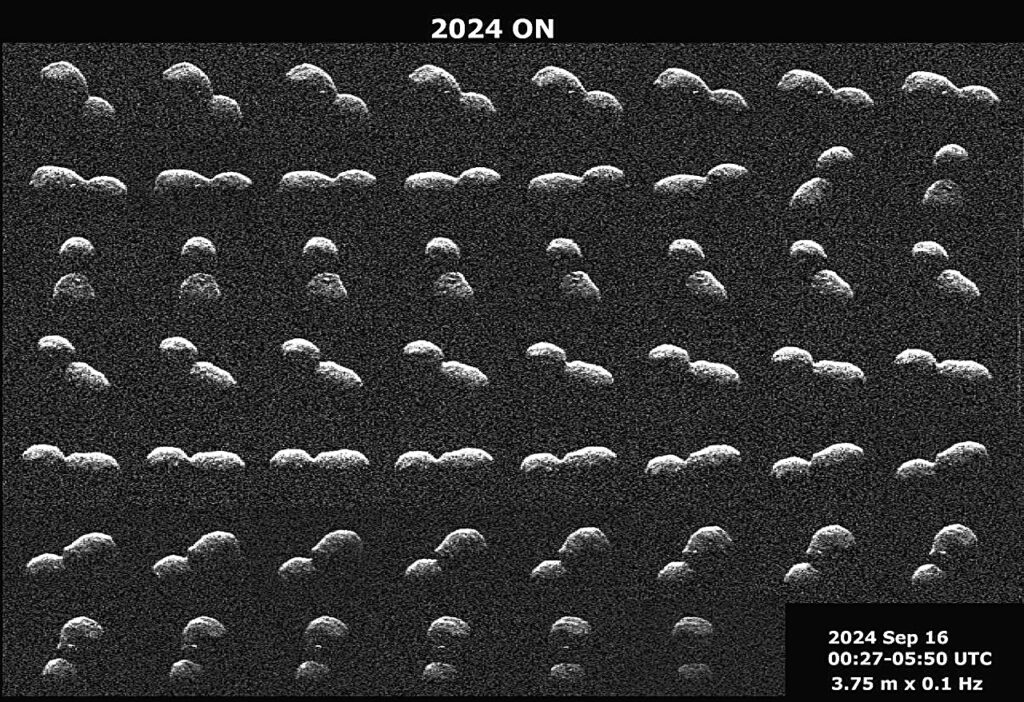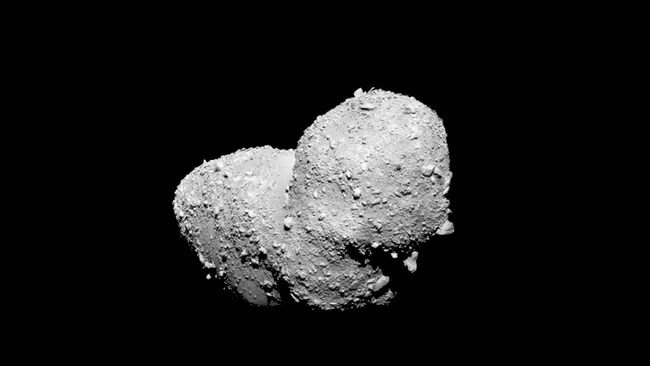The cosmos is filled with surprises, and recently, two oddly shaped asteroids gave Earth a close, yet safe, flyby. Let’s unravel the science and significance behind these peculiar space visitors.
Meet the Peanut-Shaped Asteroids
Asteroid 2024 ON and 2024 JV33 are not your typical space rocks. These asteroids are known as contact binaries, meaning they are composed of two lobes touching each other, creating a distinct peanut shape. According to NASA, about 14% of asteroids larger than 200 meters (660 feet) are contact binaries, making these objects a fascinating area of study.
2024 ON measures about 350 meters (382 yards) long, with one lobe 50% larger than the other, separated by a pronounced neck. The asteroid’s unique structure was observed using the Deep Space Network’s Goldstone Solar System Radar, which resolved features as small as 3.75 meters across, including bright boulders on its surface.

Asteroid 2024 JV33, the other peanut-shaped visitor, is also a contact binary, measuring around 300 meters (980 feet) long—about the length of the Eiffel Tower. It rotates once every seven hours, and like 2024 ON, it shows a pronounced lobe structure. These asteroids, though harmless for now, are monitored closely due to their potential future impact risks.
How Radar Imaging Reveals Asteroid Secrets
Radar imaging is a powerful tool in the study of asteroids, particularly those that venture close to Earth. Unlike optical telescopes that capture light emitted or reflected by distant objects, radar works by bouncing radio waves off the asteroid and analyzing the returning signals. This method allows scientists to create detailed images and gather critical information about an asteroid’s shape, rotation, speed, and trajectory.
Patrick Taylor, radar division head for the National Radio Astronomy Observatory, explains, “Radar is unique because it reveals physical properties of objects that light alone can’t. With radar, we can understand the asteroid’s size, shape, and movement, which is crucial for characterizing potentially hazardous objects.”
NASA’s Deep Space Network radar played a vital role in capturing the peanut shapes of 2024 ON and 2024 JV33, highlighting the importance of this technology in planetary defense. These images not only help scientists assess impact risks but also provide insights into the formation and evolution of contact binaries.
The Importance of Monitoring Near-Earth Objects
Near-Earth objects (NEOs) like 2024 ON and 2024 JV33 are constantly tracked by space agencies around the world. While neither of these asteroids poses an immediate threat, they are classified as “potentially hazardous objects” due to their size and proximity to Earth. NASA labels any object larger than 492 feet that comes within 4.6 million miles of Earth as potentially hazardous, prompting ongoing observation and study.
The monitoring of NEOs is not just about predicting potential impacts but also about understanding the broader dynamics of our solar system. These objects provide valuable clues about the early stages of planetary formation and the current processes shaping our cosmic neighborhood. Asteroids like these are remnants from the solar system’s formation, offering a window into its past.
Asteroid 2024 ON was first identified by the Asteroid Terrestrial-impact Last Alert System (ATLAS) in Hawaii, while 2024 JV33 was discovered by the Catalina Sky Survey in Arizona. These programs are part of a global effort to detect, track, and study NEOs, ensuring that any potential threats are identified well in advance. This ongoing vigilance is crucial, as it helps refine our understanding of asteroid dynamics and guides future strategies for planetary defense.
Contact Binaries: Cosmic Time Capsules
Contact binaries, like 2024 ON and 2024 JV33, are more than just oddly shaped space rocks; they are cosmic time capsules that tell the story of asteroid evolution. These objects are thought to form when two separate asteroids slowly collide and stick together, creating a single, peanut-shaped body. The lobes remain distinct but are bound by the weak gravitational forces that hold them together.
Studying these contact binaries helps scientists understand the conditions that lead to such formations and how they evolve over time. The lobes’ different sizes can offer insights into their collisional history, as well as their internal structure. The pronounced neck between the lobes could indicate areas where material was lost or redistributed due to past collisions or gravitational interactions.
Moreover, contact binaries provide clues about the environment in which they formed. The surfaces of these asteroids are often littered with boulders and craters, each telling a tale of past impacts. By examining these features, scientists can infer the forces that shaped them and the conditions prevalent in the early solar system.
Why Studying Asteroids Matters
Studying asteroids like 2024 ON and 2024 JV33 is not just an academic exercise; it’s a vital part of understanding our place in the solar system. These objects are remnants of the material that built the planets and hold keys to the processes that shaped the early solar system. Each flyby offers a unique opportunity to observe these primordial bodies and learn more about their composition, behavior, and potential impact risks.
Asteroids are also of great interest for future space exploration and resource utilization. Many asteroids contain valuable metals, water ice, and other materials that could be harvested for use in space missions or even on Earth. Missions like NASA’s OSIRIS-REx, which recently returned a sample from asteroid Bennu, demonstrate the potential for direct interaction with these objects. Understanding contact binaries could help inform future mining efforts by revealing how these bodies hold together and where the richest deposits might be found.
Furthermore, it is essential for developing strategies to protect Earth from potential impacts. By analyzing the structure and movement of contact binaries, scientists can refine models that predict asteroid trajectories and assess the effectiveness of proposed deflection techniques. Missions like NASA’s DART (Double Asteroid Redirection Test), which aims to alter an asteroid’s path, rely on accurate data about asteroid behavior to succeed.
The Future of Asteroid Research
The passing of 2024 ON and 2024 JV33 is a reminder of the dynamic nature of our solar system. These peanut-shaped asteroids, while not immediate threats, highlight the need for continued vigilance in monitoring near-Earth space. Advances in radar technology, combined with new space missions, will enhance our ability to detect and study these objects, contributing to our understanding of asteroid formation, behavior, and impact risks.
Future missions, including planned sample-return missions from other contact binaries, will provide direct access to these objects, allowing scientists to study their composition and structure in unprecedented detail. Such missions will offer insights that could one day help prevent a catastrophic impact event and guide the safe utilization of asteroid resources.
Reference:
Retrieved from NASA Website.



















